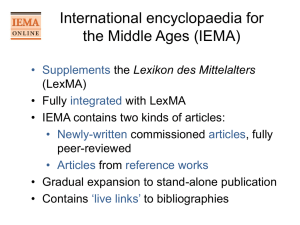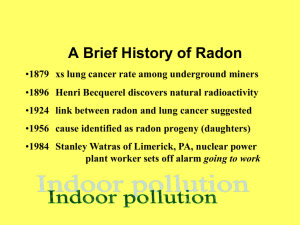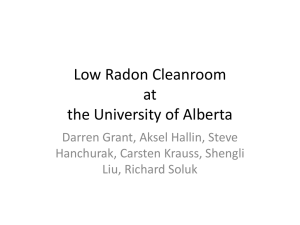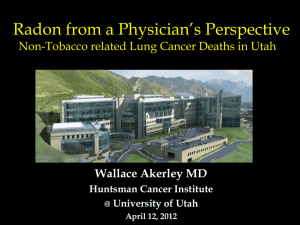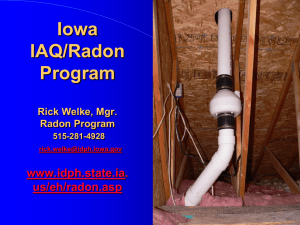State Indoor Radon Grant (SIRG)
advertisement
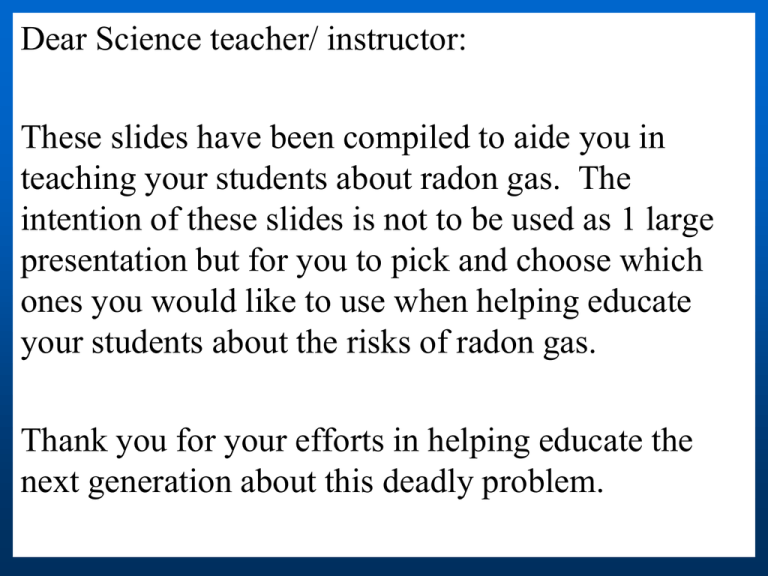
Dear Science teacher/ instructor: These slides have been compiled to aide you in teaching your students about radon gas. The intention of these slides is not to be used as 1 large presentation but for you to pick and choose which ones you would like to use when helping educate your students about the risks of radon gas. Thank you for your efforts in helping educate the next generation about this deadly problem. Radon A Science Issue What is Radon? Radon is an indoor air pollutant. Radon is a colorless, odorless radioactive gas that comes from naturally occurring uranium in the soil. The only way to tell how much radon a home has is to TEST. IEMA Surgeon General’s Warning “Indoor radon is the second-leading cause of lung cancer in the United States and breathing it over prolonged periods can present a significant health risk to families all over the country.” IEMA Did You Know? More Americans die each year from lung cancer than from breast, prostate, and colorectal cancers combined. IEMA Lung Cancer Mortality Rates Estimated Mortality of Lung Cancer in 2009 "2009 Facts & Figures" - American Cancer Society 180,000 160,000 140,000 120,000 100,000 80,000 159,390 60,000 40,000 49,920 20,000 40,610 27,360 0 Lung IEMA Colon/Rectal Breast Prostate Radon Risk Estimates USEPA’s 2003 Assessment of Risks from Radon in Homes estimates radon causes about 21,000 lung cancer deaths per year. The Illinois Emergency Management Agency and the USEPA estimate that as many as 1,160 Illinois citizens are at risk of developing radon related lung cancer each year. IEMA Test! The only way to know the radon level in a building is to test. Basement, crawl space, slab on grade or foundation combinations can have a radon problem. IEMA Sources of Radiation Exposure to US public 2009 Other - 1% Average Exposure 620 mrem Assumes average indoor radon concentration of 1.3 pCi/L. Radon is by far the greatest single source of radiation exposure to the general public. Medical X-Rays - 12% Radon - 37% Internal - 5% Nuclear Medicine – 12% CAT Scans - 24% Consumer Products - 2% Cosmic - 5% Terrestrial - 3% IEMA Source: National Council on Radiation Protection (NCRP Report 160) Radon Risk in Perspective Comparative Risk Assessments by EPA and its Science Advisory Board have consistently ranked Radon among the top four Environmental risks to the Public In 1998 Harvard Risk in Perspective, by John Graham, ranked Radon the #1 risk in the Home IEMA Did You Know? Top five causes of accidental home injury deaths: – – – – – Falls Poisoning Fires Choking Drowning Deaths due to radon induced lung cancer is greater than all of these IEMA Home Safety Council Risks 25,000 21,000 20,000 15,800 15,000 10,000 4,800 5,000 3,300 1,000 800 Choking Drowning 0 Radon IEMA Falls Poisoning Fires The History of Radon In the beginning radon was an “unknown” lung disease in miners in the 1400’s Identified in 1879 in autopsies of European miners as lung cancer (Lymphosarcoma). Excess lung cancer deaths observed in uranium miners in U.S., Czechoslovakia, France and Canada. Excess lung cancer deaths in other underground miners in Newfoundland, Sweden, Britain, France, Australia, China, and U.S. 13 IEMA Who Discovered Radon? Fredrich Ernst Dorn, a German chemist and physicist discovered radon in 1898, or 1900 (sources vary on the year). Dorn termed radon, “radium emanation”. He discovered radon while studying radium’s decay chain IEMA Radon was first called Niton Ramsey and Gray named Radon “Niton” in 1908. The pair isolated the element, determined it’s density and decided that radon was the heaviest known gas. “Niton” comes from the Latin word for shining, nitens. (Radon glows a yellow color when the temperature is lowered to below freezing, and orange red at -195°C.) IEMA Current Name Radon has been known by its current name since 1923. It was named after the element radium. The suffix “on” was used as with all other inert gases. IEMA Radon Research Both European and North American studies have been done that confirm that radon causes lung cancer. IEMA Radon Research Radon health issues emphasized when studies were combined – European Pooled Results • Collectively, these studies show appreciable hazards from residential radon. – North American Pooled Results • The combined analysis provides direct evidence of an association between residential radon and lung cancer risk. IEMA Indoor Radon Became an Issue in 1984 Stanley Watrus measured 2700 picocuries of radon per liter (pCi/L) of air in his Pennsylvania home. IEMA The Story Mr. Watrus set off alarms at the Limmerick Nuclear Power Plant when entering. The plant had alarms to detect radiation, but no radioactive material was yet onsite. The radiation came from radon in his home and clung to his clothing. The Watrus case brought the indoor radon problem to the public attention and that of the USEPA. IEMA Radioactivity and Radiation Radioactivity - Unstable atoms releasing excess energy Ionizing Radiation - energy or particles that make ion pairs during interactions with body cells IEMA Types of Ionizing Radiation Alpha particles Beta particles Gamma photons X-ray photons Neutrons IEMA Alpha Radiation (a) Alpha radiation is a particle released when the nucleus kicks out 2 neutrons and 2 protons (mass number changes by 4 and atomic number changes by 2). Alpha particle – Large in mass and charge (total charge of +2) – Effects are short in range (about 1 inch) – Primarily an inhalation and ingestion hazard IEMA 23 Alpha Particles Are Strong Enough To Pit Plastic Plastic chip from passive radon test (alpha track). Magnified only 100 times. Exposed for 3 months at EPA to Action Level of 4 pCi/L. 24 IEMA Beta Radiation (b) P+ N b- Beta Radiation is a particle which is released when the nucleus changes a neutron into a proton and a beta particle (atomic mass number remains unchanged). Beta particle – – – – Relatively small mass and charge (total charge of -1) Relatively fast moving, travels up to two meters External Hazard - Skin Burns Internal Hazard - Inhalation and Ingestion 25 IEMA Gamma Radiation (g) Gamma radiation is pure energy. It is released from the nucleus whenever an alpha or a beta is emitted. Gamma ray – – – – Pure energy, no mass, very penetrating Moves at the speed of light No charge External and internal hazard Main protection is using principles of time, distance, and shielding 26 IEMA Relative Penetrating Power Alpha Beta Gamma Paper Concrete 27 IEMA Abbreviated Uranium-238 Decay Series Uranium-238 (solid) 4.47 billion years Radium-226 (solid) 1,620 years Radon-222 (gas) 3.8 days Uranium decays to Radium and then to Radon. Uranium and Radium as solids are trapped in soil, but radon gas can move. The decay rate is expressed by “half life”. 28 IEMA The Meaning of Half Life 120 Percent Remaining 100 100 Half Life is the time required for half of the atoms to decay. It is not the time for all of the atoms to decay. 80 60 50 40 25 20 12.5 6.25 3.125 4 5 0 0 1 2 3 Number of Half Lives 29 IEMA Radon Action Level The USEPA set an action level for indoor radon concentration of 4.0 picocuries of radon per liter of air (pCi/L). USEPA selected 4.0 pCi/L because of the technological and economical bases. Risk at 4.0 pCi/L about seven (7) people out of a thousand could get lung cancer.* *A Citizen’s Guide to Radon (2005). IEMA Fate of Indoor Radon Airborne Breathable Measurable Radon-222 Radon Decay Products Plated Out Non-Breathable Non-Measurable 31 IEMA Radon Decay Product Characteristics Source of cell damage in lungs through release of alpha and beta particles (radiation) Short-lived decay products most significant Have static charges Chemically reactive Solid particles Heavy Metals IEMA 32 Radon & Short-Lived Decay Products b+1P Pb 82 -2 P -2N +1P Bi 83 a IEMA Po 84 bAt 85 Rn 86 a -2 P -2N33 Ionization Caused by Radiation can occur with a a, b, or g Atom in air Ion in air (net charge +1) Before Collision After Collision 34 IEMA Radon Exposure Radon and Radon Decay Products (RDPs) are breathed in and the Radon is exhaled. Because they are solid particles, RDPs remain in lung tissue and are trapped in the bronchial epithelium and emit alpha particles which strike individual lung cells and may cause physical and/or chemical damage to DNA. 35 IEMA What is Radon’s Chemical Profile? Radon’s atomic weight is 222. Radon’s atomic mass is (222.0) atomic mass units (amu). Radon’s atomic number is 86. Radon’s atomic volume is 50.5cm3/mol Radon’s melting point is 202 K (-95.8°F, -71.0° Celsius). Radon’s boiling point is 211.3 Kelvin (-79.06° Fahrenheit, -61.8°Celsius). IEMA Radon Chemistry Number of Neutrons in a radon atom are 136. Number of Protons/Electrons in a radon atom are 86. Radon is a gas at room temperature20°Celsius & 1atmosphere (atm). Radon Fluoride is the only confirmed compound of radon. IEMA More Radon Details! Radon is classified as a Noble Gas. Radon’s crystal structure is cubic. Radon has a half-life of 3.8 days. Radon is the heaviest known gas. Radon is characterized as a radioactive air pollutant. IEMA Radon is found everywhere Every county in Illinois has had a high radon test 36% of the homes according to the Status Report for Radon in Illinois are above the USEPA Action Level. IEMA Average Indoor Radon Concentration by County IEMA Statewide Results from IEMA Professional Licensee measurements 104,884 Homes Tested 37,710 of the homes tested were > 4.0 pCi/L 36% of the homes tests were > 4.0 pCi/L Average Radon Concentration 4.4 pCi/L IEMA How did radon originate in Illinois? Glaciers from Canada deposited uranium in the soil. Radon results from the uranium deposits. IEMA Radon Entry Radon enters through any opening between the building and the soil. radon radium uranium Pressure Differentials and Radon Entry Air pressure differentials between the building and outside air causes radon from the soil to be drawn into the house resulting in elevated indoor radon levels. IEMA Common Entry Points Foundation Wall Joint Crawlspace Sump Pits Cracks in Floors Utility Penetrations IEMA Initial screening IEMA recommends first testing with a short term test. The definition for a short term test is less than 90 days, but the average short term test lasts between 2-7 days. IEMA Who can test? The occupant of a dwelling may test their own home. Test kits are available from hardware and department stores or directly from laboratories listed on the IEMA website www.radon.illinois.gov. If hiring someone to measure radon levels, the individual must be licensed by the IEMA’s Radon Program. IEMA Illinois Radon Policy Testing is recommended throughout Illinois. Mitigation, reducing the radon problem, is recommended when radon concentrations are 4.0 pCi/L or more. IEMA Test the Footprint Footprint means each foundation type in direct contact with soil or other material. Short-term or long-term measurements shall be made in each lowest structural area suitable for occupancy. For example, a split-level building with a basement, a slab-on-grade room and a room over crawlspace shall have measurements made in each of the foundation types: the basement, a slabon-grade room and a room over the crawlspace. IEMA Detector Placement is Crucial Place in an area where the detector will not be disturbed. At least 3 feet from doors or windows to the outside. Out of the direct flow of air from a ventilation duct. At least 1 foot from exterior walls. 20 inches to 6 feet from the floor. At least 4 inches away from other objects horizontally or vertically above the detector. At least 4 feet from heat, fireplaces and furnaces, out of direct sunlight, etc. IEMA Rooms to Test Measurements shall be made in rooms that can be regularly occupied by individuals, such as family rooms, living rooms, dens, playrooms and bedrooms. IEMA If Tests Are Above 4.0 pCi/L IEMA provides a list of Professional Radon Mitigators trained to reduce radon levels. Professional Radon Mitigators and Technicians must meet specific requirements to obtain a license with IEMA. IEMA Mitigation Systems Reduce Radon by: Collecting radon prior to its entry into the building and discharging it above the highest eave. Modifying building pressure differentials. IEMA Active Soil Depressurization Active Soil Depressurization uses a fan to draw radon from beneath the house. All radon mitigation systems shall be designed to reduce a radon concentration in each area within the footprint of the building as low as reasonably achievable (ALARA). Crawl spaces must be included in a radon reduction plan. IEMA Websites www.radon.illinois.gov http.takeactiononradon.illinois.edu. IEMA Opportunities for student IEMA Radon Poster Contest Radon Video Contest Questions Patrick Daniels – (217) 782-1325 patrick.daniels@illinois.gov Cindy Ladage – (217) 785-9889 cindy.ladage@illinois.gov Fax Number – (217) 524-1254 IEMA


